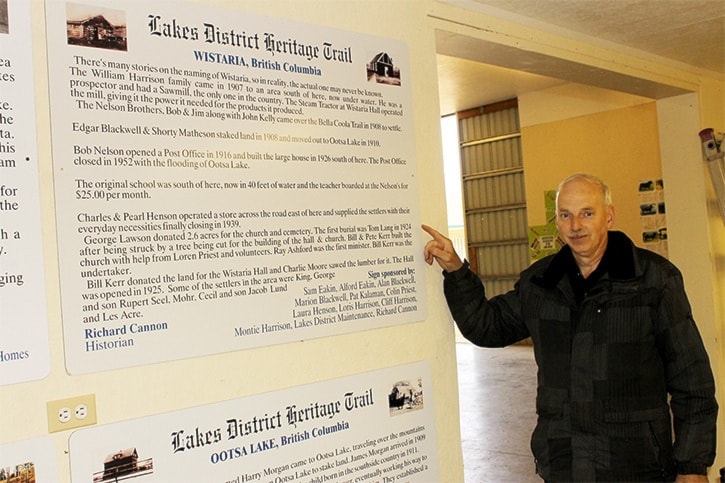“Some men are drawn to the sea, to its vastness, and its water that rolls, and toils with envy. While some are drawn to land that is prairie, so flat and lonely it cries for companionship amongst its beauty.
While others are drawn to mountains with its meadows, and forests. For it was here they settled in the vastness and wilds of the interior where the skies are painted with a touch of blue.”
That is what reads one of the 21 signs honouring the history of the Lakes District pioneers, who flooded the area in the 1800s and early 1900s.
Richard Cannon, a local historian, has been working tirelessly to create these signs for the past decade. He’s interviewed over 150 people in the area.
When all the signs are completed, they will be placed in what Cannon calls the ‘Lakes District Heritage Trail,’ which starts in Burns Lake and goes south along Hwy. 35, completes the Francois Lake loop and heads further south towards Cheslatta Lake.
The main goal of the project is to preserve the history of the Lakes District for future generations, said Cannon. “It will also add to tourism, of course, and people will have an opportunity to learn about the past.”
The signs will be placed in 18 different spots, sharing a piece of history of those locations and the incredible stories of the first settlers.
Cannon said it was important to speak directly with the second generation of settlers. “Even though the first generation has passed away, history was still fresh in the minds of the second generation,” he said. “Now we’re moving to the third, fourth and fifth generation and every time that happens a little bit more gets lost because they weren’t there to witness it.”
“The more I learn, the more interesting it is,” he continued. “There are a lot of stories that go further beyond what’s on these signs.”
Since he started interviewing people 10 years ago, some of them have passed away. “I’m glad I did what I did because that information would’ve been lost,” he said.
Cannon knew from the beginning how big this project was going to be. “At first I was quite overwhelmed because I didn’t know how the community would react to it,” he said. “But as you can see, people were very generous.”
Several donors have helped make this project become a reality by donating $25, $50 and even $400. All the sponsors’ names are written on the signs.
When Cannon didn’t receive enough donations to cover the cost of a sign, he would cover the remaining cost himself.
Although the original goal was to complete the project in 2010, the extensive research and the time required to gather all the information resulted in the project being postponed to 2017.
“If everything goes up to plan, the signs can be up next year [2017],” he said. “I know some of the families [I interviewed] are eager to have the signs up already, but it all takes time.”
Originally from the Fraser Valley, Cannon moved to the Lakes District as a small boy. On top of being the president of the Lakes District Fall Fair, Cannon works full time at the West Fraser Sawmill.
What inspired him to pursue this project was a “genuine love for the area and respect for its people.” “I think there are wonderful people in this area; they had a lot of interesting challenges coming in to this country at the time of the railroad and some prior to the railroad even.”
The community had a chance to check out the signs during the 2016 Lakes District Fall Fair. Cannon said the comments were very positive.
Since there are still two signs that aren’t fully sponsored, people can still donate by contacting Cannon directly at 250-699-8697.
“It’s very important to get this project completed,” he said. “I think the history of the area is worth preserving for future generations.”
